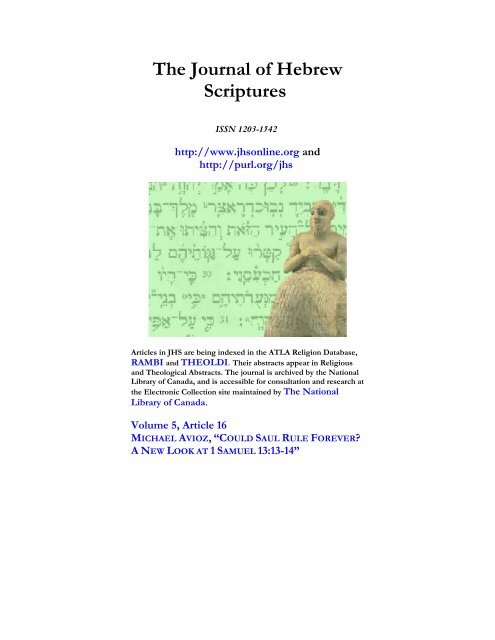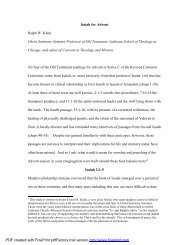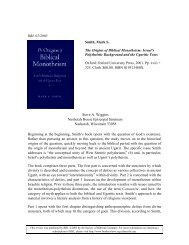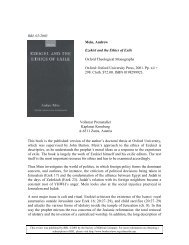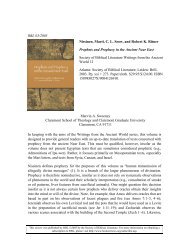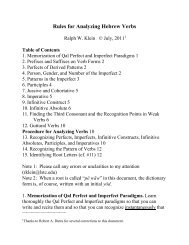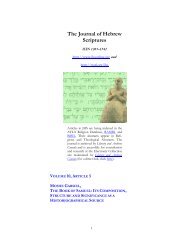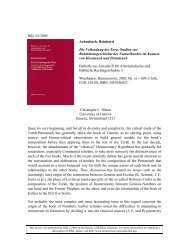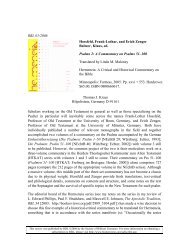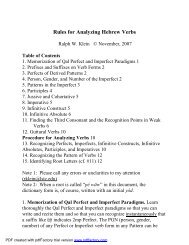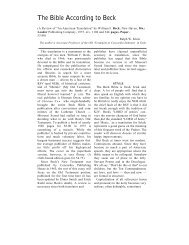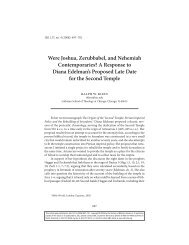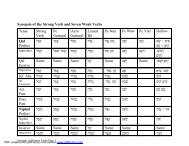could saul rule forever? a new look at 1 samuel 13:13-14
could saul rule forever? a new look at 1 samuel 13:13-14
could saul rule forever? a new look at 1 samuel 13:13-14
You also want an ePaper? Increase the reach of your titles
YUMPU automatically turns print PDFs into web optimized ePapers that Google loves.
The Journal of Hebrew<br />
Scriptures<br />
ISSN 1203-1542<br />
http://www.jhsonline.org and<br />
http://purl.org/jhs<br />
Articles in JHS are being indexed in the ATLA Religion D<strong>at</strong>abase,<br />
RAMBI and THEOLDI. Their abstracts appear in Religious<br />
and Theological Abstracts. The journal is archived by the N<strong>at</strong>ional<br />
Library of Canada, and is accessible for consult<strong>at</strong>ion and research <strong>at</strong><br />
the Electronic Collection site maintained by The N<strong>at</strong>ional<br />
Library of Canada.<br />
Volume 5, Article 16<br />
MICHAEL AVIOZ, “COULD SAUL RULE FOREVER?<br />
A NEW LOOK AT 1 SAMUEL <strong>13</strong>:<strong>13</strong>-<strong>14</strong>”
COULD SAUL RULE FOREVER? A NEW<br />
LOOK AT 1 SAMUEL <strong>13</strong>:<strong>13</strong>-<strong>14</strong><br />
MICHAEL AVIOZ,<br />
DEPARTMENT OF BIBLE, BAR-ILAN UNIVERSITY<br />
1. INTRODUCTION<br />
In 1 Samuel <strong>13</strong>, the b<strong>at</strong>tle between the Israelites and the Philistines<br />
<strong>at</strong> Michmash is described. Following military obstacles and a<br />
prolonged anticip<strong>at</strong>ion of Samuel’s arrival, Saul presents the burnt<br />
offering himself, though he was ordered in 1 Sam 10:8 to wait for<br />
Samuel. The resulting conflict between Samuel and Saul is<br />
presented in vv. 7-15a. Samuel delivers an oracle of judgment to<br />
Saul for his failure to heed the prophet’s command to await his<br />
arrival:<br />
You have done foolishly; you have not kept the<br />
commandment of the Lord your God, which he<br />
commanded you. The Lord would have established<br />
your kingdom over Israel <strong>forever</strong>, but now your<br />
kingdom will not continue; the Lord has sought out a<br />
1
man after his own heart; and the Lord has appointed<br />
him to be <strong>rule</strong>r over his people, because you have not<br />
kept wh<strong>at</strong> the Lord commanded you.<br />
Scholars who deal with this pericope generally <strong>at</strong>tempt to<br />
understand the n<strong>at</strong>ure of Saul’s sin which necessit<strong>at</strong>ed his rejection<br />
from becoming king. 1 Only rarely do they deal with Samuel’s words<br />
implying th<strong>at</strong> Saul <strong>could</strong> have reigned <strong>forever</strong>. The main problems<br />
arising from Samuel’s word to Samuel are as follows: are we to<br />
understand Samuel’s words about Saul’s everlasting kingship as<br />
reflecting his own interpret<strong>at</strong>ion, or should they be understood as<br />
resulting from a divine oracle delivered to Samuel? This question<br />
arises since there is no indic<strong>at</strong>ion in 1 Samuel <strong>13</strong> or earlier th<strong>at</strong> God<br />
has promised this to Saul. Furthermore, how are we to reconcile<br />
these words with the divine promise to David in 2 Samuel 7, in<br />
which David was promised an everlasting <strong>rule</strong>? Wasn’t the promise<br />
to David exclusive and extraordinary?<br />
1 See H.J. Stoebe, Das erste Buch Samuelis (KAT, 8/1; Gütersloh:<br />
Gütersloher Verlagshaus Gerd Mohn, 1973), 252-53; B.C. Birch, The Rise<br />
of the Israelite Monarchy. The Growth and Development of 1 Samuel 7-15 (SBLDS<br />
27; Missoula, MT: Scholars Press, 1976), 106. See also the bibliography<br />
cited in V.P. Long, The Reign and Rejection of King Saul. A Case for Literary<br />
and Theological Coherence (SBLDS 118; Atlanta, GA: Scholars Press, 1989),<br />
90-93; T.S. Vecko, “Saul – the Persecutor or the Persecuted One?”, in The<br />
Interpret<strong>at</strong>ion of the Bible: The Intern<strong>at</strong>ional Symposium in Slovenia (ed. J.<br />
Krašoveç; JSOTSS 289; Sheffield: Sheffield Academic Press, 1998): 201-<br />
2<strong>14</strong>.<br />
2
2. ANALYSIS<br />
Some scholars are of the opinion th<strong>at</strong> the narr<strong>at</strong>or presents<br />
Samuel’s words as the prophet’s own innov<strong>at</strong>ion r<strong>at</strong>her than<br />
God’s. 2 This opinion derives from the lack of an explicit divine<br />
oracle delivered to Samuel (or “messenger formula”), containing<br />
instructions to convey its content to Saul. 3 In Amit’s view, “this<br />
st<strong>at</strong>ement by Samuel can be interpreted as personal commentary<br />
th<strong>at</strong> contains rhetorical exagger<strong>at</strong>ion.” 4<br />
She brings the text from 1 Samuel <strong>13</strong> as a demonstr<strong>at</strong>ion of<br />
her thesis th<strong>at</strong> biblical characters may be design<strong>at</strong>ed as unreliable.<br />
Brueggemann5 argues th<strong>at</strong> the narr<strong>at</strong>or cre<strong>at</strong>es intentional<br />
ambiguity, so th<strong>at</strong> the reader will doubt both Samuel’s and God’s<br />
intentions and interests.<br />
2 See for example Y. Amit, “‘The Glory of Israel Does not Deceive or<br />
Change His Mind’: On the Reliability of Narr<strong>at</strong>or and Speakers in Biblical<br />
Narr<strong>at</strong>ive,” Prooftexts 12 (1992), 209; R. Alter, The David Story. A Transl<strong>at</strong>ion<br />
with Commentary of 1 and 2 Samuel (New York: Norton, 1999), 73.<br />
3 W. Brueggemann, First and Second Samuel (Interpret<strong>at</strong>ion; Louisville,<br />
KY: Westminster / John Knox, 1990), 100; R. Polzin, Samuel and the<br />
Deuteronomist. A Literary Study of the Deuteronomic History, Part II: 1 Samuel<br />
(Bloomington: IUP, 1989), 127. This classific<strong>at</strong>ion is based upon C.<br />
Westermann, Basic Forms of Prophetic Speech (trans. H.C. White;<br />
Philadelphia, Westminster Press, 1967), 100-115.<br />
4 Amit, “The Glory of Israel,” 209.<br />
5 Brueggemann, Samuel, 101.<br />
3
Other scholars consider vv. <strong>13</strong>-<strong>14</strong> deuteronomistic, since they<br />
allude to N<strong>at</strong>han’s oracle to David in 2 Sam 7:12, 16. 6 And since 2<br />
Samuel 7 is regarded as deuteronomistic, so is 1 Sam <strong>13</strong>:<strong>13</strong>-<strong>14</strong>.<br />
In the following, I intend to contest each of these arguments<br />
separ<strong>at</strong>ely.<br />
(a) These scholars assume too much rigidity in Westermann’s<br />
formulaic c<strong>at</strong>egories. Westermann’s formulas of prophetic speech<br />
are, in fact, very flexible, as Westermann himself argues, and this<br />
example of prophetic speech in 1 Samuel <strong>13</strong> may still have been a<br />
prophetic judgment speech, even without the introductory<br />
“messenger formula.”<br />
(b) This view supposes th<strong>at</strong> Samuel lied to Saul, or waited to<br />
the appropri<strong>at</strong>e opportunity to get rid of Saul. However, there is no<br />
basis for this assessment of Samuel in the book of Samuel. On the<br />
6 M. Weinfeld, Deuteronomy and the Deuteronomic School (Oxford:<br />
Clarendon Press, 1972), 336, # 16; T. Veijola, Die ewige Dynastie. David und<br />
die Entstehung seiner Dynastie nach der deuteronomistischen Darstellung (AASF.B<br />
193; Helsinki: Suomalainen Tiedeak<strong>at</strong>emia, 1975), 56-57; P.K. McCarter, I<br />
Samuel (AB 8; New York: Doubleday, 1980), 228-30; M.A. O’Brien, The<br />
Deuteronomistic History Hypothesis: A Reassessment (OBO, 92; Freiburg:<br />
Universitätsverlag, 1989), <strong>13</strong>1; P. Mommer, Samuel: Geschichte und<br />
Überlieferung (WMANT, 65; Neukirchen-Vluyn: Neukirchener, 1991), <strong>13</strong>5-<br />
37; S.L. McKenzie, “The Trouble with Kingship,” in Israel Constructs its<br />
History: Deuteronomistic Historiography in Recent Research (ed. A. de Pury, T.<br />
Römer, and J.D. Macchi; JSOTSup, 306; Sheffield: Sheffield Academic<br />
Press, 2000), 309-310.<br />
4
contrary, Samuel is described as a reliable character, apart, perhaps,<br />
from 1 Sam 16:2-4, in which he was ordered by God to tell a lie. 7<br />
(c) Was the principle of dynastic succession prevalent in the<br />
days of Samuel and Saul? A few scholars answer this question in<br />
the neg<strong>at</strong>ive. 8 In their view, Saul and David <strong>rule</strong>d in virtue of a<br />
divine gift (charisma), r<strong>at</strong>her than through any principle of dynastic<br />
succession. However, other scholars9 argue th<strong>at</strong> all kings in the<br />
ancient Near East were regarded as chosen by the deity. Moreover,<br />
there is serious doubt whether a charism<strong>at</strong>ic view was held in<br />
ancient Israel in the time of Saul and David10. 7 For a discussion of this story as well as other stories in which<br />
prophets seem to lie, see Y. Shemesh, “Lies by Prophets and Other Lies<br />
in the Hebrew Bible,” JANES 29 (2002), 81–95.<br />
8 See, among others, A. Alt, “The Form<strong>at</strong>ion of the Israelite St<strong>at</strong>e in<br />
Palestine,” Essays on Old Testament History and Religion (Oxford: Blackwell,<br />
1966), 171-237; M. Noth, The History of Israel (London: A & C. Black, 2nd<br />
edn, 1960), 228-30; J. Bright, A History of Israel (London:<br />
Westminster/John Knox, 1972), 234-35, 271; F. Crüsemann, Der<br />
Widerstand gegen das Königtum (WMANT, 49; Neukirchen-Vluyn:<br />
Neukirchen Verlag, 1978).<br />
9 See the references in R.R. Hutton, Charisma and Authority in Israelite<br />
Society (Minneapolis, MN: Augsburg Fortress, 1994), 71-83; Tomoo Ishida,<br />
History and Historical Writing in Ancient Israel: Studies in Biblical Historiography<br />
(SHCANE, 16; Leiden: Brill, 1999), 171; Z. Ben Barak, “The St<strong>at</strong>us and<br />
Right of the Gebira,” JBL 110 (1991), 29; K. Spanier, “The Queen Mother<br />
in the Judean Court: Maacha – A Case Study,” in A. Brenner (rd.), A<br />
Feminist Companion to Samuel and Kings (Feminist Companion to the Bible,<br />
5; Sheffield: Sheffield Academic Press, 1994), 187, n. 2.<br />
10 See Beyerlin ,“Königscharisma,” 186-201; A. Malam<strong>at</strong>, “Charism<strong>at</strong>ic<br />
Leadership in the Book of Judges,” in Magnalia Dei. The Mighty Acts of God:<br />
Essays on the Bible and Archaeology in Memory of G. Ernest Wright (eds. F.M.<br />
Cross et al.; Garden City, NY: Doubleday, 1976), 152-68. When speaking<br />
of the ‘charism<strong>at</strong>ic leadership’, Malam<strong>at</strong> confines himself in the era of the<br />
judges and does not continue to the reign of Saul.<br />
5
Th<strong>at</strong> monarchy in Israel was hereditary from its inception is<br />
clear from the law of the king in Deut 17:20 11: “Th<strong>at</strong> his heart may<br />
not be lifted up above his brethren, and th<strong>at</strong> he may not turn aside<br />
from the commandment, either to the right hand or to the left; so<br />
th<strong>at</strong> he may continue long in his kingdom, he and his children, in<br />
Israel.” According to this law, the covenant with the king includes a<br />
covenant with his dynasty. Saul himself hoped th<strong>at</strong> his son<br />
Jon<strong>at</strong>han would inherit his throne (1 Sam 20: 30-31), and after the<br />
de<strong>at</strong>h of Saul and Jon<strong>at</strong>han, Abner appointed Ish-bosheth<br />
(Eshbaal) as king of Israel. A similar view is taken by J. Liver12 who<br />
writes on Saul: “Saul also seems destined to have a kingdom not<br />
only for himself, but also for his descendants, and only<br />
circumstances caused the fall of the house of Saul”. As La<strong>at</strong>o has<br />
shown, the idea of the royal succession was inherent in the royal<br />
ideology of the ancient Near East. <strong>13</strong> After reviewing m<strong>at</strong>erial from<br />
various texts from the ancient Near East, he concludes th<strong>at</strong><br />
11 See A.D.H. Mays, Deuteronomy (NCB; Grand Rapids: Eardmans;<br />
London: Marshall, Morgan & Scott, 1979), 270; G.E. Gerbrandt, Kingship<br />
According to the Deuteronomistic History (SBLDS, 87; Atlanta: Scholars Press,<br />
1986), 108-16; D. Jobling, I Samuel. Studies in Hebrew Narr<strong>at</strong>ive and Poetry<br />
(Berit Olam; Collegeville, MN: Liturgical Press, 1998), 80.<br />
12 J. Liver, “King, Kingship,” Encyclopedia Biblica (Jerusalem: The Bialik<br />
Institute, 1964), IV, 1091 (Hebrew). Cf. W. Beyerlin ,“Das<br />
Königscharisma bei Saul,” ZAW 73 (1961), 197; M. White, “‘History of<br />
Saul’s Rise’: Saulide St<strong>at</strong>e Propaganda in 1 Samuel 1-<strong>14</strong>,” in “A Wise and<br />
Discerning Mind”: Essays in Honor of Burke O. Long (ed. S.M. Olyan and R.C.<br />
Culley; Brown Judaic Studies 325; Providence, RI: Brown Univ., 2000),<br />
286.<br />
<strong>13</strong> See the references in A. La<strong>at</strong>o, “Second Samuel 7 and Ancient Near<br />
Eastern Royal Ideology,” CBQ 59 (1997), 244-69.<br />
6
“nothing indic<strong>at</strong>es th<strong>at</strong> the idea of an eternal dynasty was limited to<br />
either an early or a l<strong>at</strong>e period.” <strong>14</strong><br />
(d) The argument th<strong>at</strong> vv. <strong>13</strong>-<strong>14</strong> in 1 Samuel <strong>13</strong> are<br />
deuteronomistic (on the basis of the appearance of the eternal<br />
dynasty motif in 2 Samuel 7) seems like a circular argument: if 2<br />
Samuel 7 is l<strong>at</strong>e, 15 than 1 Samuel <strong>13</strong>, who alludes to it, must be l<strong>at</strong>e<br />
too. Space limit does not allow me to discuss N<strong>at</strong>han’s oracle in<br />
depth here, and therefore I will summarize briefly my views<br />
regarding the d<strong>at</strong>e and composition of 2 Samuel 7. Scholars who<br />
view N<strong>at</strong>han’s oracle as a l<strong>at</strong>e composition, do it on the basis of the<br />
differenti<strong>at</strong>ion between conditional and unconditional covenants.<br />
According to their view, unconditional covenant is regarded as<br />
belonging to an early d<strong>at</strong>e, while the conditional reformul<strong>at</strong>ion is<br />
assigned to the hands of l<strong>at</strong>er (post exilic) editors. 16 However, this<br />
differenti<strong>at</strong>ion was contested by several scholars, most recently by<br />
<strong>14</strong> L<strong>at</strong>to, “Second Samuel 7,” 263. Cf. G. Beckman, “Royal Ideology<br />
and St<strong>at</strong>e Administr<strong>at</strong>ion in Hittite An<strong>at</strong>olia,” in Civiliz<strong>at</strong>ions of the Ancient<br />
Near East, ed. J. Sasson et al. (New York: Scribner, 1995), Vol. I, 533: “In<br />
most societies of the ancient Near East, kingship was normally passed<br />
from f<strong>at</strong>her to son.”<br />
15 For a review of the various suggestions concerning the redactional<br />
layers in 2 Samuel 7, see Dietrich, W. and T. Naumann, Die Samuelbücher<br />
(Erträge der Forschung, 287; Darmstadt: Wissenschaftliche<br />
Buchgesellschaft, 1995), 153-56.<br />
16 See M. Weinfeld, “The Covenant of Grant in the Old Testament<br />
and in the Ancient Near East,” JAOS 90 (1970), 184-203. For a list of<br />
scholars following Weinfeld’s argument, see J.D. Levenson, “The Davidic<br />
Covenant and Its Modern Interpreters”, CBQ 41 (1979), 205-19. For a<br />
critique of Weinfeld see G.N. Knoppers, “Ancient Near Eastern Royal<br />
Grants and the Davidic Covenant: A Parallel?,” JAOS 116 (1996), 670-97.<br />
7
Freedman and Miano. 17 It is my opinion th<strong>at</strong> N<strong>at</strong>han’s oracle<br />
should be d<strong>at</strong>ed to the Tenth century BCE. 18 The covenant<br />
between God and David contains elements of vassal tre<strong>at</strong>ies<br />
known to us from Hittite texts from the thirteenth century BCE. 19<br />
In addition, the description of a king who desires to build a<br />
house for his god is well <strong>at</strong>tested in hymns and royal building<br />
inscriptions from the early beginnings of civiliz<strong>at</strong>ion. 20 If my<br />
arguments are sound, then the conclusion might be th<strong>at</strong> allusions<br />
made by the author of Samuel to N<strong>at</strong>han’s oracle in 2 Samuel 7<br />
17 D.N. Freedman and D. Miano, “The People of the New Covenant,”<br />
in The Concept of the Covenant in the Second Temple Period, eds. S.E. Porter and<br />
J.C.R. de Roo (JSJSup, 71; Leiden: E.J. Brill, 2003), 7-26. See also M.<br />
Haran, “The Bĕrit ‘Covenant’: Its N<strong>at</strong>ure and Ceremonial Background”,<br />
in Tehilla le-Moshe: Biblical and Judaic Studies in Honor of Moshe Greenberg, eds.<br />
M. Cogan et al. (Winona Lake, IN: Eisenbrauns), 203-19; J. Milgrom,<br />
“Covenants: The Sinaitic and P<strong>at</strong>riarchal Covenants in the Holiness Code<br />
(Leviticus 17–27)”, in Sefer Moshe: The Moshe Weinfeld Jubilee Volume, eds.<br />
C.A. Cohen et al. (Winona Lake, IN: Eisenbrauns, 2004), 91-101.<br />
18 For an early d<strong>at</strong>e of the book of Samuel, see recently B. Halpern,<br />
David’s Secret Demons: Messiah, Murderer, Traitor, King (Grand Rapids, MI:<br />
Eardmans, 2001), 57-72.<br />
19 See P.J. Calderone, Dynastic Oracle and Suzerainty Tre<strong>at</strong>y (Manila:<br />
Manila University, 1966); J. Kim, Psalm 89: Its Biblical-Theological Contribution<br />
to the Presence of Law within the Unconditional Covenant (PhD dissert<strong>at</strong>ion; Ann<br />
Arbor, MI, 1989), 351 ff.<br />
20 V.A. Hurowitz, I Have Built You an Exalted House. Temple Building in<br />
the Bible in Light of Mesopotamian and Northwest Semitic Writings (JSOTSup,<br />
115; Sheffield: Sheffield Academic Press, 1992); Richard E. Averbeck,<br />
“Sumer, the Bible, and Compar<strong>at</strong>ive Method: Historiography and Temple<br />
Building,” Mesopotamia and the Bible: Compar<strong>at</strong>ive explor<strong>at</strong>ions (eds. M.W.<br />
Chavalas and K. Lawson Younger, JR.; Grand Rapids: Baker, 2002), 88-<br />
125; M. Avioz, N<strong>at</strong>han’s Oracle (2 Samuel 7) and Its Interpreters (Bern: Peter<br />
Lang, forthcoming).<br />
8
cannot be used as a proof for presenting Samuel’s oracle to Saul as<br />
a l<strong>at</strong>e addition.<br />
3. SUMMARY AND CONCLUSIONS<br />
According to the view presented in this paper, Samuel’s oracle to<br />
Saul in 1 Samuel <strong>13</strong>:<strong>13</strong>-<strong>14</strong> should be regarded as authentic r<strong>at</strong>her<br />
than deuteronomistic or as a fabric<strong>at</strong>ion of Samuel himself. Neither<br />
the author of Samuel nor Samuel invented the idea of a royal<br />
dynasty. It was known many years before the time of Samuel.<br />
Therefore, Saul <strong>could</strong> have established a dynasty, in which his sons<br />
will be the future <strong>rule</strong>rs of Israel. Why this did not happen is, of<br />
course, another m<strong>at</strong>ter. According to the book of Samuel, Saul’s<br />
religious misconduct as a king has made him lose the crown for the<br />
sake of David.<br />
9


